Middle School Version |
 |
Screenplay
Copyright © July 2007 by Steven P. Kennedy
Note:
The purpose of this film is to conserve wildlife, enhance habitat and especially
to encourage local forest restoration initiatives through stewardship contracts
in the
| Storyboard Sketches by: Alex Mizuno and Alison
Jeffs |
The
Cannonball Express
Dedication:
This
video is dedicated to the brave firefighters who fought the Angora Fire of 2007.
Opening
Clips from Angora Fire footage donated by Bruce Brown and Gordon Morganstern
from WebTV.net
1) Fire trucks with sirens and lights
2) Diagonal flame-fire in the tree tops
3) Marching firefighters
4) Helicopter
5) Air Tanker
6) Smoke in the air
7) Wind blowing tree branches
8) Untouched house with green lawn and lawn mower
9) †Smoke wafting
across the lake
10) †Damage report
by Sheriff
11) †Burned homes
and cars
12) †
13) †Angry man with
question
14) †Weather report
15) †Excerpt from
a magazine article entitled, ďWhat Tahoe Area Fire Chiefs SayĒ. This quote appears
as scrolling titles and is taken from a special issue of California Forests Magazine
that was published by the California Forestry Association in the Fall of 2006, almost a year prior to the Angora Fire.
ďChief
Whitelaw: We face a constant challenge balancing the science of healthy forests
and the science of managing the lake to conserve its clarity, and we can do both.
We work real hard to press the forest health part, but we get countered by those
that donít want us to work in the ďstream environment zonesĒ, in the wet areas.
They donít want disruption that will cause even small deposits of silt to reach
the lake. In the meantime, the forests continue to grow overstocked and we struggle
during the season to put fires out. Eventually, if we donít get this thing turned
around, weíre going to miss one and itís going to take out a drainage or a community and devastate the lakeís clarity.
Weíre a long way from getting this problem tackled. ď
Video
Clips of Lake Tahoe, snow capped mountains, red sunset, casino lights, sparkling
alpine streams and mountain meadows.
Voice
Over Narration:
††††† The high country is a beautiful place isnít
it? Where else can you find such beautiful natural scenery so close to good schools,
good friends and high paying jobs in the gaming, skiing and tourist industries?
††††† Not surprisingly, many of the homes in your
neighborhood are owned by out of town families who visit occasionally and arenít
aware of the fire risk their vacation homes face every summer. Out of sight. Out of mind as it were.† They say that one personís dream is another
personís nightmare and for Fire Marshals like me, this neighborhood has become
a hundred million dollar disaster, waiting to happen. Like the residents of Tahoe
Paradise discovered in June and July of 2007, your forest, your house and your
neighborhood could all be gone tomorrow.
††††††† With you and most of your neighbors concentrating
on making a living, weíve concluded that a more imaginative approach to fire safety
is needed. We all know what it is like to be controlled by forces we cannot name,
yet sense are omniscient.†
Having said that, Iíll quit preaching to the choir, forego
the usual lecture on defensible space and give you something beautiful instead.† So climb aboard The Cannonball Express and enjoy
the show.
BIRDS
CHIRP, MURMUR OF CONVERSATION,
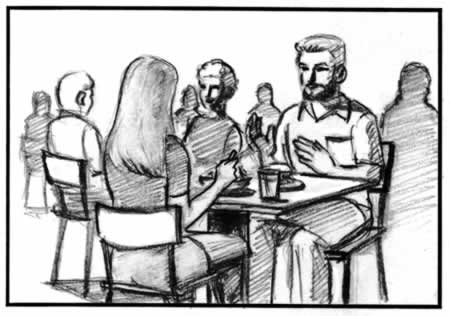
Sketch
by Alex Mizuno
SILVERWARE TAPS AGAINST
PLATES.
PAN to elegantly dressed COUPLE (Helen and Jess).
PULL BACK TO REVEALÖ
Couple sits at dining table between The Yosemite Mountain-Sugar Pine Rail Side Station Cafe and the forest.
Couple enjoys brunch.
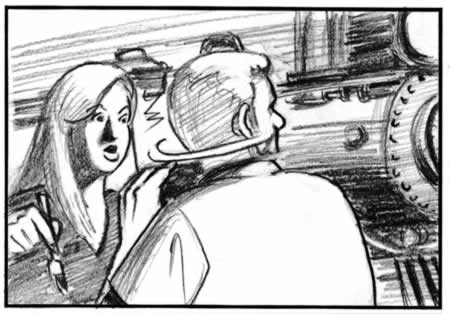
Sketch
by Alex Mizuno
Sound f/x locomotive nears
rush of fore wind.
. .
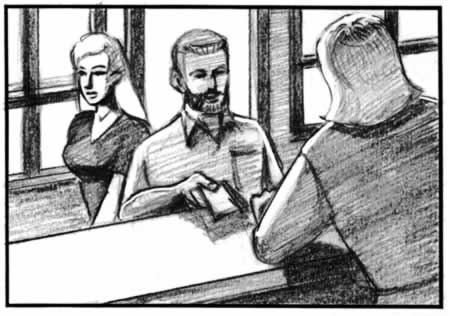
Sketch
by Alex Mizuno
(Narrator)
(Voice 0ver) Trains are a lot like suburban brushfires. They come and they go
in the wink of an eye.
Yet,
the memory of their passing lives on, long after the smoke has cleared.
LOUD WHISTLE SHRIEKS WARNING
head-on shotÖlocomotive barrels down
(Title
Shot)† The Vegetation
Management Video Project Committee Presents
††††††††††††††††††††††††††††††††††† The Cannonball
Express
PASSING
TRAIN RATTLES table contents & RUFFLES coupleís composure.
(Jesse)
What was that?
(Waiter)
The Cannonball Express, an historic steam engine. Wasnít she beautiful? (waiter exits)
(Helen)
You just need a cup of coffee.
(Jesse)†
I donít need a cup of coffee after that.
(Helen)†
Jesse, we need to talk.
(Jesse)†
About what?
(Helen)†
About the house.
(Jesse)†
I thought it was perfect. It is perfect. Itís amazing. Itís everything
we dreamed about.
(Helen)†
No, not quite. The Fire Marshal saidÖ..
(Jesse)†
What were you doing talking to the Fire Marshal?
(Helen)†
You didnít even notice. A house down the street nearly burned to the ground.
And I got really worried. Do you know we canít get any decent fire insurance because
the insurance companies have red lined our entire neighborhood? It doesnít make
any sense to me because I thought you took care of it.
(Jesse)†
They havenít red lined it. They are just limiting their exposure. Anyway,
itís beautiful, its quiet, itís a great place to raise
a family. And thereís not much we can do about it now. Weíve already moved in.
Iíve got a friend from volleyball and he can come and take care of the whole thing
for us, no problem..
(Helen)
Ok, but I donít think we can afford that. Ok look, talk to who ever you need to.
Just go buy some gloves because we have some work to do.
(Helen
slaps money down on table and leaves.)
(Jesse
puts glasses on and obviously distressed, thinks deeply, scratching his chin.)
(Narrator)
(V. O.) Even before the devastation of the Angora Fire of 2007, it became apparent
to government officials from many different agencies that communities nestled
around the
DAGUERREOTYPE SHOTS of Native Americans burning brush.
(Narrator) (V. O.) Where the Native Americans
used to burn Jeffrey pine forests in the
Freight
train blasts by
(Narrator) (V. O.) At one agency, the South Tahoe Public Utility District, officials were concerned that a major fire would complicate the water treatment process.
Animal wildlife in forest Ė day
(Narrator)
(V. O.)† USDA† Forest Service
biologists were also concerned about the impact a major fire would have on native
plants, fish and animal communities. The Forest Service is responsible for 75%
of the land in the
And
the Lahontan Water Quality Control Board and Tahoe Regional
Planning Agency were concerned that mechanized fuel reduction projects in creek
corridors and wetlands would increase erosion and increase the growth of algae
in the
Crystal clear waters
of
(Narrator) (V. O.)
Given wide-spread public opposition to smoke from controlled burning, congestion
from additional truck traffic and noise from chain saws, it was evident that a
new approach was needed. Hand crews cost up to $5,000 an acre, so mechanized fuel
reduction projects that cost less than $2,000 per acre, were started. But labor
and equipment maintenance costs were higher than in areas outside the
Vegetation shots Ė day
(Narrator) (V. O.)† The
US Forest Service has worked since 1987 to reduce fuel loads in the
Ext. forests and suburbs Ė day
(Narrator) (V. O.)†
With funding a perennial problem, agencies struggled to reduce the risk
of a catastrophic wildfire while protecting other resources.† The stakes were high. In the
Tahoe vistaĖ day
(Narrator) (V. O.) Creeks in the affected watersheds,
generally flow into the marshes at the south end of
Ext.††† work crew clearing pine duff and treesĖ day
(Narrator)
(V. O.) On the
Land around private home Ė day
(Narrator) (V. O.) Private homeowners and wood lot owners whose fire threat arises from land outside the scope of these work crews may sometimes need permits from TRPA, but can always hire independent contractors or do the work themselves.
Ext.† Heavily forested hillside Ė day
PAN view of suburbia below.
(Narrator) (V. O.) In the larger scheme, a public private approach is necessary. (PAUSE) Letís meet one of those independent contractors whoíll share some secrets of good forest management.
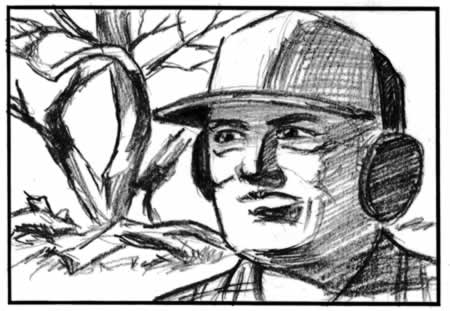
Sketch
by Alex Mizuno
†††††††††††††††††††††††††††††††††††††††††††† The Tree Cutterís Lesson
Note: The goal of this scene is to introduce the tree
cutter, his tools and techniques to the homeowner and the homeowner association.
This will help homeowners decide whether to hire a professional or do the work
themselves.
Susan Donaldson, a weed expert and Ph.D at UNR, provided much appreciated advice for this scene
re: weeds and erosion.
CAMERA
FINDS BRIAN WALLACE, arms smeared with pitch and sawdust, as he cuts tree branches
with a Stihl chainsaw. Brian STOPS.
Removes face shield. SEES Jess
(Jesse) Sorry to barge in on you like this.
(Brian) No problem. Howís the fixer upper? (Takes a sip of water from canteen. Sits down at crude table.)
(Jesse) Itís a half million dollar headache if you ask me.
(Brian) Arenít they all?
(Jesse) Yeah, but itís better than downtown
(Brian) Yeah
(Jesse) But I can think of a lot of things I should have noticed on the first walk through. Like the smoke detector going off all night. (with irritation) Anyway, Helen has this nesting instinct and all the trees around the place are making her nervous. She wants to do all the painting because sheís artistic.† The problem is, she wants me to do the landscaping and I donít know the first thing about gardening. Green thumb? Iíve got a bad case of mouse finger.
(Brian) The first thing you ought to do is get a ladder and clean out the rain gutters. Then measure the windows for storm shutters.
Take the numbers down to the hardware store, load up some† plywood† and the clerks will take care of the rest for you. And if a window ever gets broken, replace it with those argon gas filled, double paners. The argon is heat insulating and it will prevent your drapes from catching fire. (This factoid courtesy of Steve Chilton, a branch chief with TRPA.)
So what do you need?
Jesse:† Can you come over and help us out?
(Brian) I wish I could. Iím booked solid for weeks.
(Jesse) Can you recommend anyone?
(Brian)† Well, truth be told, itís not as hard as it looks. Thereís a lot you can do with a wheel barrow, a rake, some loppers, a bow saw and a pole saw. I bet you could do your place in a week end, three days tops.
(Jesse)† It makes me tired just thinking about it.
(Brian)† Well, look at this place, I figure another three hours on this project and Iíll have it clean as a whistle. You know, my business card says Iím with Bushwhackers Tree Service but that gives people the wrong impression.
Jesse: Like you go around whacking bushes ?
(Brian)† Youíre sick, Jesse, sick. And No, actually, that Iím some kind of a tree surgeon. I mean, Iíll take out ugly clumps of dwarf mistletoe from branches, if they want me to, for New Years eve or whatever, but actually, most of what I do is tree removal. Weíll also do trimming near power lines, windows and chimneys, topping, selective logging, brush chipping, stump grinding and wood splitting. Most guys in my trade use boom lifts but I prefer to strap on spurs and climb the tree the old fashioned, lumber jack way. Itís safe, if you know how to do it. Iíve been at this for 12 years and Iíve never taken a fall.
(Brian beams.)
QUICK CUT to Brian climbing and rappelling down a tall tree trunk.
(Brian) (V. O.) Ya know, some these homeowners have begged me to take out trees that werenít properly marked. If thereís a tree in front of their picture window, removing the tree can add $100,000 to the value of the home. But if the paint isnít the right shade of blueÖÖits Ďcause they mixed their ownÖIíve flat out refused those bogus jobs. The boss and I split the profits and I split my half with my crew. But I ainít gonna pay no fine to TRPA for taking out a tree thatís not on the permit and my boss doesnít want the hassle either.
The official paint has a marker that they can test for. Itís specially formulated. TRPA will give you a permit to take out trees for a lot of reasons. But a big tree thatís healthy and separated from other treesÖ.forget it.† I tell you, 60 Minutes should do a story about the shenanagins with this program, people poisoning trees, dumping salt water on Ďem, collecting pine bark beetles out in the forest and releasing them on a tree at home so they can say that their healthy tree is diseased. Iím an honest man and I put in an honest dayís work for an honest dayís pay. Go figure.
(Brian feeds tree branches into grinder.)
(Brian) (V. O.) Usually, one hour of climbing and cutting makes for two man hours of grinding and hauling away.
(Back to Brian)
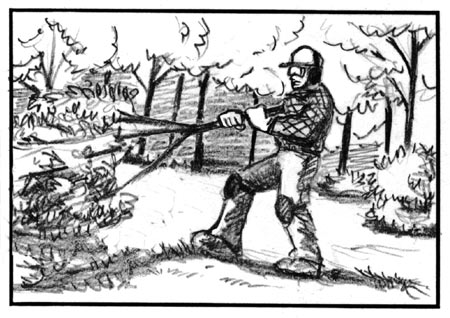
Sketch
by Alex Mizuno
(Later)
(Brian GESTURES towards the house.)
(Brian) Now, while Iím being paid by the homeowner to reduce the risk that a fire might ROAR up the hill and take out his house. I am a member of the Sierra Club. And I do take the environment into consideration when Iím deciding what goes and what stays.
(Brian
RISES. Walks towards tree.)
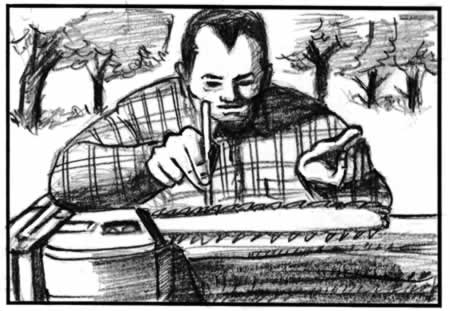
Sketch
by Alex Mizuno
(Brian) Take this
white fir for example. The loggers took out all the big Jeffrey pines to shore
up the mine shafts in the
(Later)
(CLOSE UP† Brianís arms smeared with pitch and sawdust.)
(Jesse)† Had any close encounters with wildlife lately?
(Brian) Not recently but Iíve seen some amazing critters in those trees. I see lots of hawks and owls. An occasional eagle eating a fish or rodent. Most of Ďem I like but when the squirrels chatter at me, I know theyíre just jealous of my climbing ability. Usually if Iím up there cutting, theyíll jump to another tree or come down the back side of the trunk. I topped one tree with a squirrel in the top branches and he rode it down like Doctor Strangelove and ran off. I guess he felt lucky that day.
(Jesse)† He should have been playing the lottery !
(Brian) Yeah. Pretty much.
(Brian looks around.)
(Brian)† Donít tell my wife about that one. She thinks
the rascals are cute.
(Jess) reaction shot of shared mirth
(Brian sizes up his work thus far.)
(Brian) When I started on this project, it was really thick here. Iíve already made several trips to the dumps and itís starting to look pretty good. (Brianís arms stretch out towards the hill.) Look how steep this hill is! It could have been done with a boom truck but climbing a tree causes a lot less erosion than shoveling dirt and bringing in a truck. When Iím done clearing, Iíll re-seed it with wild flowers and grasses that are native to this area. (Makes a throwing motion as if scattering seed.) I told the homeowner, I could make it look like a park.
(Jess)† Iím starting to get the picture.
(Later)
(Brian stands at pile of debris.)
(Brian) Most of what I take out is white fir, scarlet campion and brush.
(Brian extracts a campion plant from ground.)
(Brian) Scarlet campion is the worst of the exotics. It is beautiful but it is terribly invasive. You can still get Yellow Toadflax at some plant nurseries as an ornamental. It is invasive too. And if you canít buy it then your clueless neighbors will give you some. That stuff comes in and the wildlife heads for the door.
(Turns campion over† in his hand.)
(Brian) We just donít have any insects or animals that go to town on campion. It looks nice. Got a pretty flower that bees likeÖbut, it just takes over. It lines the logging roads in some areas. All it takes is some disturbed soil and a single seed to get an infestation going. The Invasive Weed Coordinating Group works harder than I do to map and control all kinds of weeds.
(Tosses campion onto pile.)
(Brian) Campion comes back quickly from seeds dropped the previous year. Iíll make a follow-up visit in six months to yank out volunteers.
Thereís another one
called knapweed. It occasionally comes in mixed with the mud on bulldozers treads,
on loads of timber or framing from the
(Authorís Note: these stats from a research study published in Weed Technology in 1989 per Tahoe weed expert Susan Donaldson)
Roofs and decks arenít half the problem that weeds are when it comes to pumping topsoil into the lake.
That run off means no soaking in and no ground water for the trees late in the summer.† Knapweed and pepperweed acreage usually increases following a wildfire burn. The stuff just wonít die. A creeping ground cover called pinemat manzanita is good for keeping the weeds down if you want to invest the time and money to get it established.
(Brian walks up hill.)
(Brian)† The natives that grow back here attract deer and rabbits with succulent new growth. The only trees Iím eager to take out are the ones that just donít belong.
(FLAPS hand at white fir.)
(Brian)† White fir is high on my list. Itís a native but it smells bad when it burns, it sucks up too much water and it contributes to global warming. Itís not even any good for lumber. Get this.† Snow reflects winter sunlight back into space, right?† Dark green fir branches absorb the heat and leaves it floating around here on earth. I never thought Iíd complain about Tahoe being too warm. Go figure
(QUICK CUT TO† MELTING GLACIER AND ICE BERGS CALVING INTO OCEAN.)
(Jesse)
What about the
(Brian) (V. O.) A friend of mine from my firefighting days told me the duff layer was several feet deep in that area.
(Jesse) Wow ! No wonder they couldnít stop it.
(Back to scene Ė day)
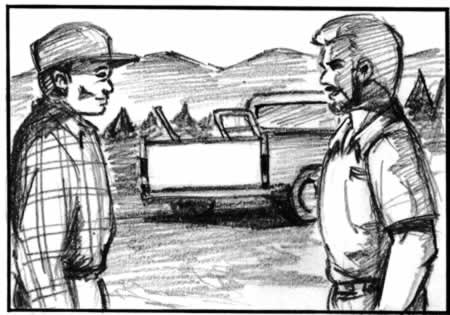 (Brian stands before white
fir.)
(Brian stands before white
fir.)
(Brian) Hardware stores had a run on saws, rakes and loppers
all over
(Brian down at truck.)
(Brian) Once the initial cleaning is done, annual vegetation management is easy. No real secret to what I do. Just be careful with the tools and watch out for power lines.
(Puts tools in truck.)
(Brian) Lots of my customers do the annual maintenance themselves, but, I keep tabs on Ďem. Good for business. Olí Bri is the cheapest fire insurance around.
(Brian waves to leave. Turns back.)
(Brian) Want to know more about native plants? Go see Jon Bellows.
(Jesse) From Sierra Club volleyball?
(Brian) Yeah thatís him. He knows more than me. Shoot! He even grows Ďem and eats them.
(Jesse) Hey, thanks for the advice.
(Brian) No problem. And if you break a leg falling out of a treeÖ.donít come running to me.
(Jesse) (laughs) I wonít.† (waves good-bye to Brian.)
†††††††††††††††††††††††††††††††††
The Naturalistís Scene
Note:
The goal of this scene is to introduce residents (who didnít go to grade school
locally) to the history of the area and to the plants and animals that can still
be found in the nearby national forests (and often roaming through their neighborhoods
at night).
Ext. canyon Ė day
CAMERA PANS canyon to
Ext. hillside with gardenĖ day
Pile of pine needles and folded blue plastic tarp lay on ground.
Jon
Bellows, athletic, outdoorsman, wood sculptor, methodically rakes up needles,
separating out the pine cones.
(Jon) Hey, I know you. Donít you play volleyball at Truckee High?
(Jesse) I hack at it. I get in a good spike once in a while.
(Jon) Brian let me know you were coming. What do you need to know?
(Jesse)† Brian said you knew a lot about native plants.
(Jon) Stalking the elusive sitanion hystrix are you?
(Jesse)† I guess so.
(Jon sets aside rake. APPROACHES Jessie. Points to FENCE.)
(Jon) (Pointing)†
See that? I built that fence myself. Got my flower garden
in there and my bee hive. (Motions with head) Thereís deer in that canyon.
And theyíre hungry! Those succulent native grasses are for them. The gardenís
for me. We have a short growing season and I need to make the most of it. I couldnít
find a bear proof fence so I built that beehive out of sheets of Kevlar I got
from a kayak factory in
(Jesse)† reaction shot - chuckles
(Jon)† Even the baddest bears give up on the idea of stealing honey from my hive after theyíve swatted it a few times and nothiní happens except for a few bee stings on the nose.† It takes a couple of hours for the bees to settle down and thereís no major damage to the bear. Ya know, African villagers have figured out that the elephants that raid their crops and get drunk on their corn mash are afraid of bees. The elephants get those angry African bees inside their trunks and ouch!, they head for the hills. So the agronomists tell the farmers to place their hives strategically and are working on a little battery powered device that buzzes like a hive of bees. Clever huh?† All I gotta do is get a recording of whatever animal a black bear is scared of, a grizzly bear or Godzilla or whatever. †Iíve heard that used kitty litter, full of clumps and whatever, will keep a bear away from your trash can. The bearís instincts tell it that itís a cougar and so the bear passes it by for easier pickinís elsewhere.
(Jesse) Good idea.
(Jon) Anyway, about once a year a bunch of my bees take off with a new queen and find a new nest in a hollow log or somethiní. The black bears can have that honeycomb. I like my wild mountain honey and the wax is good for casting jewelry.
(Later)
(Jon sits. Looks up hillside.)
(Jon)
Thereís bobcats out there. Raccoons.
Porcupines, Tree squirrels. Cougars I suppose. An occasional
coyote, the econobox of predators and song dog of Indian
legend. There's a group called The BEAR League that
teaches people and bears about the boundary lines and the rules that both species
must follow to co-exist in this shared mountain forest. All I can say is you'll
never catch me taking a snooze 60 feet up in a pine tree. Iíve seen so many of
them now, I know what they smell like. Like
a big wet dog, times a hundred. (This factoid courtesy of Beth Moxley, owner/president
of Rockwood Tree Removal.)
††††† The BEAR people are on a first name basis
with a lot of those bears and they really get upset when people plant fruit trees
in their yard and then get a depredation permit from Fish & Game because the
bears are coming to dine in their yards and breaking branches off their apple
trees.† Then poor Oliver gets shot and another
young bear moves into the neighborhood and does the same thing.
†††† We have a lot more black bears in
(Jesse)
Weíre gonna look like fools if the Russians or the Chinese
get there first with the most.
(Jon)†† yeah-up† The last thing we want is a shortage
of bears.
(Later)
(Jon)
Yeah, Iím no rocket scientist but I do know a lot about native plants.†
Iím just getting into the grasses. I always assumed,
the grasses were natural. But, no-oo! All of
those hyper competitive annuals came over with the cows and sheep. Yup, this all
used to be just logged over forest and overgrazed range land.†
Ya know. Fire doesnít cause erosion. Fire
and the hoof.† Fire
and the plow.† Fire
and the axe. That causes erosion. Scotch on the rocks.†
(Jon HOLDS up pot.)
(Jon) This is pinegrass. It should do well, here, on the edge of the woodland with plenty of sunshine. It provides good forage and cover for wildlife. Good for controlling erosion. Tolerates sandy soil. Should grow about waist high.
(Jon picks up another plant.)
(Jon) This is a squirrel tail. Excellent for recovering areas overgrown with weeds.
(Jon pulls toadflax.)
(Jon) Thereís not much that competes with toad flax. But, for fire protection, Iíve got blue bunch wheatgrass.
(Holds up pot.)
(Jon)† It stays green late into summer without watering. So, it really has to be a hot day before itíll burn. And, if I water once in a while, it really shouldn't. Itís also longest lived of the native grasses, so itíll be here for awhile. Iím going to plant a lot of this. Here, take a packet of native grass seed. Iíve got plenty of it.
(Jesse) Thanks.
(Jon walks over to tarp.)
(Jon) And this stuff?
(FOOT POKES pile of pine needles on tarp.)
(Jon) Is going straight into the gully.
WALKS
OVER to gully.
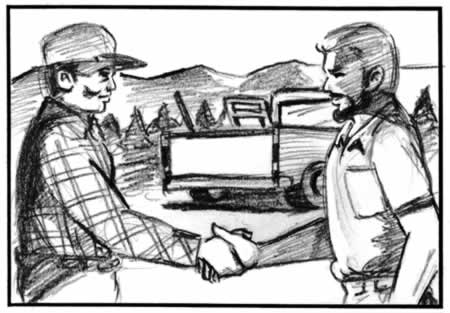
Sketch
by Alex Mizuno
(Jon) This ditch
wasnít near this deep when I was a kid. (DUMPS IT IN) And this is just from street
run-off. See the end of the culvert, there.
They
finally built an infiltration pool and lined it with cobbles.
(Pan to culvert)
(Jon) (V. O.) If all the vegetation on this hill was burned off in a fire, thereíd be massive amounts of run-off every time it rained. Thereíd be nothing to throw in the ditch to stop the run-off.
Steady cam GOES WITH Jonís return to work area. Grabs rake. Leans on it.
(Jon) Thereís a gully across the canyon, there, thatís thirty feet deep with SHEER walls.
(Pan to gully)
(Jon) When it rains, all the water from the storm drains pours down this canyon, then, out to the river. No chance to soak into the ground. Itís kind of like what happens with a bad fire.
(QUICK CUT TO
(Jon) (V. O.) The pine needles in the soil gets so hot, the resins in the pitch can form a hydrophobic layer like wax cardboard, where the water canít penetrate. It just runs off. Thatís why thereís these terrible floods after every major fire. Dry country flash floods are a sight to behold.
(Stock shot of multicolored and sinuous, desert canyon wall)
(Jon) (V. O.)
Water canít soak in. Thereís nothing to hold it.
(Jesse) Thereís got to be a better way.
(Jon) Indeed ! Hey, tell Brian I said he should get a REAL job.
(Jesse) I will and thanks for the grass seed. Iíll see you at volleyball.
(Ext. Day† Jesse leaves. Envelope stuffed with grass seed drops onto car seat. Jon kneels to tend his grass plugs. )
End of Naturalistís Scene
(Narrator) As weíve seen, there are several different varieties of fuel reduction. If youíve gotten the go ahead, you can do it yourself or pay to have it done.
†(Narrator) (cont.) The wise homeowner who gets this far will re-plant with fire-resistant shrubs or native grasses. Even in the poorest soil, this will provide year-round protection from erosion and fire and be a source of beauty as well.
The Botanistís Scene
Note:
The goal of this scene is to introduce residents to alpine botany and to native
plants that will:
a) offer little in the way of fuel to an oncoming
forest fire
b) hold the soil in place during a heavy rain
or sudden snow melt
c) offer food and shelter to wildlife such as
mountain quail
d) bloom in the spring time
Note:
The plants mentioned in this scene are from an article written by Ed Smith, a
Natural Resource Specialist with UNR Cooperative Extension. More information was
offered by the botanically minded Shelly Perry. Further suggestions on appropriate
plants are greatly appreciated.
(
(Narrator) (cont.) Letís see how our newly enlightened first-time homeowners will simultaneously manage a fuel break for beauty, erosion control, habitat and fire protection.
CAMERA FINDS AND GOES WITH SUV as it cruises
TURNS
INTO
Station wagon parks on shoulder. EXIT Helen.
Helen wears a long dress. HOLDS long shopping list in hand.
Blue Jay CALLS
Helen walks to office. Pokes head in.
(Helen) Hello-oh! Anybody here?
No reply.
WALKS down path looking at plants and garden art.
Female nursery WORKER clad in blue jeans approaches.
Slips cordless phone in back pocket.
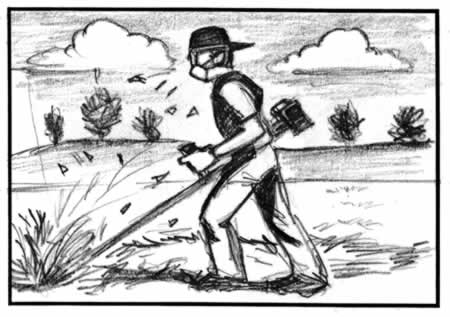
Sketch
by Alex Mizuno
(Worker)
Good morning. Can I help you?
(Helen) I want to buy some plants.
(Helen hands list to worker. Reads down list.)
(Worker) Some of these we have. Some we donít. What kind of garden are you trying to grow?
(Helen) Itís not a garden. Itís to protect the houseÖfrom fire. My husband and I want good plants out back.
(Worker) You mean fire resistant? Plants that hold the soil?
(Helen nods.)
(Worker) I can help you. How many square feet?
(Helen) Our lot is about eighty feet wide. Some forest service men came in. The area they cleared is from here to that big tree.
Ext. Day Stately Jeffrey Pine with wind chimes on lower branches.
(Worker) Thatís about fifty feet.
(Helen) And, itís all downhill.
Ext. Shot- Helen and Jessieís property on side of hill Ė day
Burnt soil in back of house.
(Worker) (V. O.) Fifty by eighty. Thatís four thousand square feet. One bush every ten square feet. Thatís about four hundred plants.
(Helen) (V. O.) (In shock) Four hundred? Oh, no. Not that many. That wonít even fit in my car. (giggles) And money doesnít grow on bushes, you know.
(Back to
(Worker brings wheelbarrow for Helen. Cameo shot opportunity for VIP/supporter here)
(Worker) Why donít you put in the wheelbarrow whatever you can afford? Iíve also got wild flower seed you can plant yourself.
(Helen) Oh, wonderful. My children will love that. The workmen burned all that slash last week. Can we plant the seeds in the ash?
(Worker)† Oh yes. Ash is good fertilizer. And the heat from the fire sterilizes the decomposed granite soil and kills the weed seed.
Any of the seed that doesnít sprout this year, will sprout next year. It might have migrated downhill a little bit from the rain but its always worth the wait.
Ext. Helen and Jessís property Ė day
(Helen) (V. O.) There was so much duff. And that blackened scar is so ugly. But, I guess they had to do it.
(Worker) (V. O.) Yes, pine needles keep on dropping.
Ext. Angora forest fire Ė day
(Worker) (V. O.) Forest fires have been part of the Tahoe Basin landscape for thousands and thousands of years. That is, until we came along. Anyway, after a fire, most forests will come back. Even stand replacing fires often leave islands of green among the charred ruin of the forest.
When a fire creeps downhill at night it usually isnít doing much damage.
(Back
to
(Helen and Worker push wheelbarrow down path.)
(Helen) (shocked) Does that mean that most of what the workers hauled away will be back?
(Worker) In time, yes. Unless you clear it yourself. Or, establish these plants, nearby. (holds Helenís list) Theyíll compete for available water and sunlight and keep saplings from getting a toe hold.
(Helen) (shakes head) I donít like paying for permits and all that red tape.
(Worker) What permits ?† TARPaís regs donít cover normal veg management unless you plan to do some major digging or take out major trees.
(Helen) Youíre right.
(Worker) All the natives are fire adapted. The plants on your list can be heavily pruned when they get too big. Then, vigorously, re-sprout like nothing happened.
(Helen) What do you have thatís on my list?
(ext. dogwood)
(Worker) (V. O.) We have dogwood. Thatís over here. It has beautiful fall colors and bright red, bare branches all Winter long.
(Worker lifts one)
(Worker) Theyíre five bucks each and do best with some drip irrigation.
(Helen) Weíve got that installed already. Iíll take four.
(Worker hands Helen a dogwood in black plastic container. Tears off sprig from another plant. Crumples it.)
(Worker) Here, smell this.
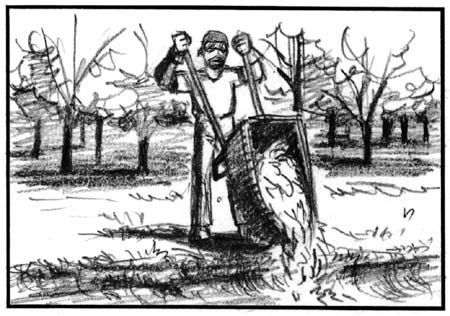
Sketch
by Alex Mizuno
(Helen) (sniffs) Oh, thatís
wonderful!
(Worker) Itís Sage. When itís in bloom, the fragrance is heavenly. (PAUSE) This species is deer resistant and does best in full sun.
It also attracts butterflies.
Where do you live? Are you near the
(Helen) No, weíre over the hill in Truckee.
(Worker) Does the hillside get afternoon sun?
(Helen) Morning.
(Worker) That puts you on a south facing slope. Fires burn hotter on the south face of a slope.
(Helen) And, weíre at the top of the hill.
(Worker) Thatís a double-whammy.
(Helen) My husband insists we do everything fire safe.
(Ext. man on ladder cleans rain gutters Ė day)
(Helen) Every month, heís up on the ladder, cleaning pine needles out of the rain gutters. He even wants to go in with a neighbor for one of those foam spray units to cover the house with foam.
(Int. Nursery aisle Ė day)
(Helen and Worker push wheelbarrow. Worker picks up another plant container.)
(Worker) This Mahala Mat or Squaw Carpet likes to grow on hillsides in part-shade. It stays very low and spreads widely without being invasive. That means it wonít be a good ladder fuel and carry flame into the tree branches. It is very fire resistant and deer resistant too. This ground cover, pinemat manzanita, (Arctostaphylos nevedensis) does a good job of holding soil. Also, it provides cover and food for mountain quail. A lower altitude alternate is Kinnikinick or Bear Berry† (Arctostaphylos uva-ursi)† Did you see our resident flock of quail, driving in?
(Helen) No, but I heard them. Such a beautiful sound.
(Worker) Thatís the male calling his flock together.
(Helen) How much for the squaw carpet?
(Worker) One gallon container - $6. 00 each.
(Helen) Iíll take five. Do you take VISA?
(Worker) Of course.
(Wild strawberry plants.)
(Worker) (V. O.) Thereís sulfur flower buckwheat and phlox over here. The buckwheatís an herbaceous perennial. Needs a little water, now and then.
(Helen) (V. O.) No problem, there.
(Worker) (V.O.) Phlox is just† wonderful.
(Ext: plants-day)
(Worker) They offer the best fire retardation and drought resistance.
Youíre lucky you came here. Not all nurseries carry these native plants. Silly isnít it?
(Helen) (V. O.) (Excited) Yeah! Letís round out the wheelbarrow with those and come back for more.
(HELEN AND WORKER PUSH WHEELBARROW out to station wagon.)
(Helen) Youíre a long way from the nearest fire station. What precautions have you against fire?
(Worker) A fire evacuation plan, if worst comes to worst. Weíve got the
BMP rain barrel that catches water from the rain gutters, for spot fires.
(Helen) BMP ?
(Worker) Best Management Practices to prevent erosion and keep Tahoe blue.
(Helen) Oh
(Worker)† If it's half full, that's at least four big paint buckets of water we can throw at it.
We can pump water from the well. Weíve got floating, gas powered porta-pumps
to drop in the fish ponds if the electricity goes out.
(Coiled up fire hose)
(Worker) Weíve got fire hose all coiled up andÖ (Ladders against rear side of storage shed)
(Worker) (cont.)Öa bunch of ladders against the back of that shed, in case, the embers start falling on our heads.
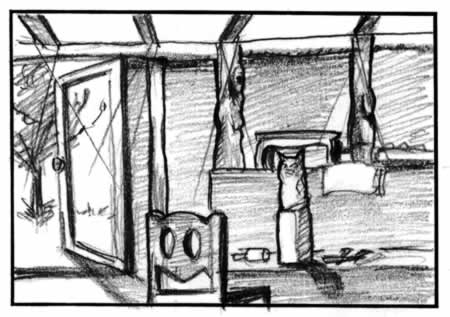
Sketch
by Alex Mizuno
(SUV)
(Helen and Worker arrive)
(Helen) You know, getting fire insurance these days is difficult. They wonít write a new policy unless someone else drops out.
(Worker) Tell me about it. A lot of my neighbors own their homes, free and clear and donít even have fire insurance.† It is not required and a lot of them donít want to spend an extra thousand bucks a year on homeownerís insurance.† They know the value of the property is in the land, not in the 50 year old cabin that sits on it. Some lots are worth more without a home than with one. Go figure.
(Helen and Worker unload wheelbarrow.)
(Worker) Plants we can re-grow. Greenhouses can be rebuilt. If we had to
evacuate, thereíre a few plants Iíd grab. But I wouldnít take any chances.
(Helen) (nods) Not worth the risk.
(Worker) (shrugs) A fire would
prove how fire-adapted these natives are. Itíd set us back but weíd recover. We
all fear the worst, but hope for the best.
(Helen) Itís just one of those
things you have to plan for.
(Worker) All of my friends who survived
the big fire say it pays to be prepared.
(Helen) You know people who
survived Angora?
(Worker) (triumphantly) Oh sure. My sister-in-law came
through with flying colors.
(Helen) I'd love to talk to her. First hand
experience is hard to beat.
(Worker) I can arrange that. Let me give
her a call and ask if Ingrid can spare you a few minutes. I was going to deliver
this packet of wildflower seeds I got from TRPA but you can save me the trip.
(Helen) Ok. I can do that.
(Worker) (pulls out cell phone and
talks softly while Helen loads up the car)
(Worker) I've got it all set
up. She's expecting you. On your way out of town, take a right on Lake Tahoe Boulevard
and head into Tahoe Paradise. She lives on Grizzly Mountain Court. You can't miss
it. There's a sign above the front door that says, "Casa Vanderheiden".
It's the only house on the block that didn't burn.
(Helen) Thank you
so much. I'll be sure to give her the seeds. And when I get home, the first container
Iím going to plant is the sage. Whenever I smell it, Iíll be reminded of you and
my first visit to Aspen Hollow.
(Worker) Thanks, and you'll like Ingrid.
She a great friend. See you next time.
(Helen waves and drives off)
(End of Botanistís Scene)
____________________________________________________
The Survivor's Scene
The purpose of this scene is to teach homeowners
what to do before, during and after a suburban forest fire.
(Helen parks
her car, exits and approaches Ingrid, who is working on a motorcycle on the driveway.)
(Ingrid) (rubbing her greasy hands on a rag) Hi. How ya doin?
(Helen)
Oh Pretty good. Nice bike.
(Ingrid) Thanks. It gets me there.
(Helen) Karen, over at the nursery, asked me to deliver this packet of seeds and
uh,...I thought I could ask a few questions and get some tips on surviving a forest
fire. (hands the packet to Ingrid)
(Ingrid) Sure, I'd be glad to. Oh
this is neat. What have we got here? (reading the contents....)
Lupine, blanket
flower, durar hard fescue, blue flax, Rocky Mountain penstemon, sulfur buckwheat,
Siberian wallflower and scarlet gilia. hmmm...
This place could use a little
color and some erosion control. (camera pans dead trees and fire blackened tree
trunks.
(Helen) So where were you when the fire started?
(Ingrid)
Oh, at home. Doin' the usual. I think I was on the computer when I heard the first
siren. I didn't think much of it but then I saw the column of smoke goin' up and
up. When they didn't have it out in the first 15 minutes then I knew it wasn't
a house on fire. And then I started movin'. We already had the defensible space
and the fire safe landscaping in place, Thank God.
(Helen) So what did
you do?
(Ingrid) Well, the thing was, I didn't know how much time I had.
So I did the most obvious things first. I put the bike in the metal storage shed.
I turned the car around in the driveway and turned on the car radio so I could
hear the emergency bulletins. I put an extension ladder up against the house so
I could check the rain gutters for pine needles and left it there for the firemen.
I got the garden hose and started spraying water like crazy. I think I even squirted
water into the attic through the air vents. I filled buckets. I wet down the deck
and soaked the garden. I set up the sprinkler and started grabbin' stuff out of
the house.
(Helen) Like what?
(Ingrid) Oh and I called some
neighbors and rang some doorbells. But they weren't home. I dunno. Stuff? Well
let's see. I got my jewelry and Carl's saddle. That went into the trunk of the
car. I grabbed what financial records I could find and some pictures and DVD's
and stuffed them into my pillow case. I must have looked like a burglar runnin'
out the door like that. I was looting my own house!
(Helen) I guess
(Ingrid) And then I heard more and more sirens and started smellin' that
smoke and then I started goin' nuts. I yanked down the drapes and curtains away
from the windows. I closed the blinds. I shoved the couch away from the picture
window so the radiant heat wouldn't catch it on fire. I closed every door in the
house. I said good by to the fish in the tank. I really didn't think this place
was goin' to survive, but it did.
(Helen) You were really lucky.
(Ingrid) I guess so, but so many of our neighbors never bothered with the
basics.
And they came home to piles of junk and ash.
(Helen) I
saw it on the news.
(Ingrid) It was really sad. Go figure. And now it's
hammers and power saws, all day, every day. The place will never be the same again.
Most of our neighbors will be strangers again or people on vacation. It's really
heart breaking. And now I've got survivor's guilt to cope with because I did the
smart thing. We're going to have to paint and remodel this place now, just to
keep up with the Jones's. This fire was like urban redevelopment I tell you. Wiped
the slate clean.
(Helen) I guess so. I quit counting the destroyed homes
on my way in here when I got to thirty something.
(Ingrid) The total
was over a hundred and fifty but the economic damage to the economy of South Lake
Tahoe was probably more like a billion dollars. Tourists will be looking at that
fire scar on the mountain for decades and wondering what happened to their nice
view from the balcony.
(Helen) Yeah, I suppose. Thanks for the tips.
(Ingrid) Whatever. I hope you never need to use any of it and if you do,
just remember that its not over until the last pitch of the last inning. I mean,
you could have a little fire smoldering in the attic and not realize it because
the smell of smoke in the air is so over powering.
(Helen) Yeah, that's
right, 'cause fires really stink. Its like living in a bad neighborhood. You have
to keep your eyes open all the time.
(Ingrid) One bad fire can ruin
your whole day.
(Helen) I'd rather have a bad case of guilt and deal
with clutter than have to start all over with nothing.
(Ingrid) That's
it. Keep those two by fours, standing up in the forest and prevent global warming.
(Helen) Right! Can I come back in the spring and check out your flower
garden?
(Ingrid) Sure. I'll look forward to seeing you.
(Helen)
Thanks. I'll bring you some more flower seeds.
(Ingrid) bye (waving as
Helen drives away).
(fade out)
(End of The Survivor's Scene)
Closing: Angora Fire clip: Smoking ruins of a house
Epilogue
Screen #1:
The
Angora Fire of 2007 caused $150 million in property damage, cost $11 million precious
tax dollars to fight and left hundreds of families homeless. This stupendous damage
tally continues to climb as tourism falls off, algae clouds the
†
Epilogue
Screen #2:
A
lot more than a forest burned in the Angora Fire. Turnover in the Tahoe Paradise
will probably be close to 70% as old time families sell out and the nouveau riche
take advantage of bare lots and bargain real estate prices.†
Animals suffered too, as they tried to escape the flames. Most of the animal
victims had only faint collective memories of fire and so, few instincts to guide
them. A lot of good wildlife habitat was destroyed and even with rehabilitation,
will take decades to return to what it once was.
Epilogue
Screen #3:
A
fire this socially and environmentally destructive does not have to happen again,
although there may be other severe wildfires in the
Epilogue
Screen #4†
This
film was funded with grants from the ÖÖÖÖÖÖÖ..
(Closing
Credits with Theme Music)